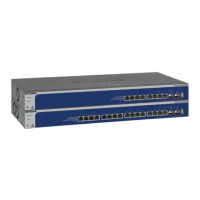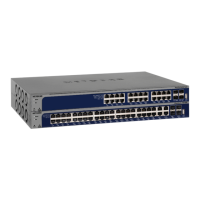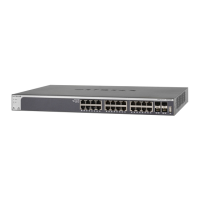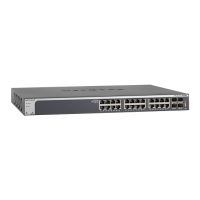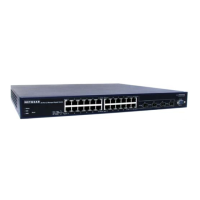Configuration Examples
413
XS708T, XS712Tv2, and XS716T Smart Managed Pro Switch User Manual
Virtual Local Area Networks (VLANs)
A local area network (LAN) can generally be defined as a broadcast domain. Hubs, bridges,
or switches in the same physical segment or segments connect all end node devices. End
nodes can communicate with each other without the need for a router. Routers connect LANs
together, routing the traffic to the appropriate port.
A virtual LAN (VLAN) is a local area network with a definition that maps workstations on
some basis other than geographic location (for example, by department, type of user, or
primary application). To enable traffic to flow between VLANs, traffic must go through a
router, just as if the VLANs were on two separate LANs.
A VLAN is a group of computers, servers, and other network resources that behave as if they
were connected to a single network segment—even though they might not be. For example,
all marketing personnel might be spread throughout a building. Yet if they are all assigned to
a single VLAN, they can share resources and bandwidth as if they were connected to the
same segment. The resources of other departments can be invisible to the marketing VLAN
members, accessible to all, or accessible only to specified individuals, depending on how the
IT manager set up the VLANs.
VLANs present a number of advantages:
• It is easy to do network segmentation. Users who communicate most frequently with each
other can be grouped into common VLANs, regardless of physical location. Each group’s
traffic is contained largely within the VLAN, reducing extraneous traffic and improving the
efficiency of the whole network.
• They are easy to manage. The addition of nodes, as well as moves and other changes,
can be dealt with quickly and conveniently from a management interface rather than from
the wiring closet.
• They provide increased performance. VLANs free up bandwidth by limiting node-to-node
and broadcast traffic throughout the network.
• They ensure enhanced network security. VLANs create virtual boundaries that can be
crossed only through a router. So standard, router-based security measures can be used
to restrict access to each VLAN.
Packets received by the switch are treated in the following way:
• When an untagged packet enters a port, it is automatically tagged with the port’s default
VLAN ID tag number. Each port supports a default VLAN ID setting that is user
configurable (the default setting is 1). The default VLAN ID setting for each port can be
changed on the Port PVID Configuration page. See Configure Port PVID Settings on
page 131.
• When a tagged packet enters a port, the tag for that packet is unaffected by the default
VLAN ID setting. The packet proceeds to the VLAN specified by its VLAN ID tag number.
• If the port through which the packet entered is not a member of the VLAN as specified by
the VLAN ID tag, the packet is dropped.
• If the port is a member of the VLAN specified by the packet’s VLAN ID, the packet can be
sent to other ports with the same VLAN ID.
